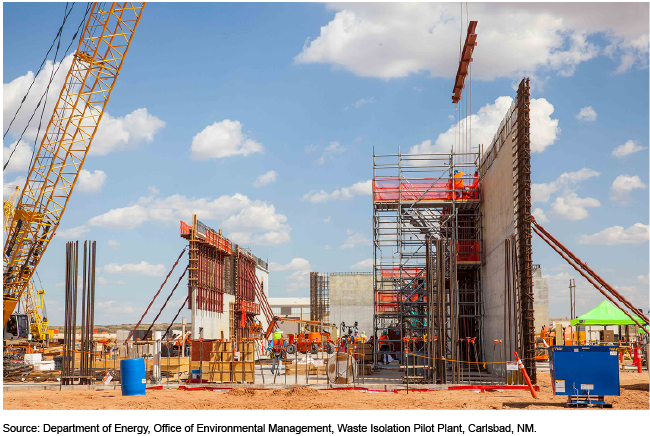The new ventilation system at WIPP now estimated to take 4 more years and $200 million more dollars than original estimates.
NEW Report from the U.S. Government Accountability Office March 15, 2022 https://www.gao.gov/products/gao-22-105057
 The Waste Isolation Pilot Plant (WIPP), near Carlsbad, New Mexico, is the nation’s only facility for disposal of certain defense-related nuclear waste. The Department of Energy (DOE) identified two root causes for cost increases and schedule delays in its project to install a new ventilation system at WIPP (see figure). The facility is currently operating at a reduced capacity because of ventilation issues in the underground waste disposal areas. The root causes DOE identified were (1) its contractor’s inexperience managing construction projects and (2) an inability to incentivize staff to work in Carlsbad. DOE also identified more specific problems with this ventilation project, and has taken corrective actions to address them. While some of these corrective actions may also help to address the root causes, the extent to which these actions will do so is unclear because DOE is not required to develop a corrective action plan for addressing the root causes and does not have a process to determine whether root causes have been sufficiently addressed. Without such a plan and process, DOE cannot ensure that root causes it identifies for cost increases and schedule delays in the WIPP ventilation project or other projects will not persist or recur.
The Waste Isolation Pilot Plant (WIPP), near Carlsbad, New Mexico, is the nation’s only facility for disposal of certain defense-related nuclear waste. The Department of Energy (DOE) identified two root causes for cost increases and schedule delays in its project to install a new ventilation system at WIPP (see figure). The facility is currently operating at a reduced capacity because of ventilation issues in the underground waste disposal areas. The root causes DOE identified were (1) its contractor’s inexperience managing construction projects and (2) an inability to incentivize staff to work in Carlsbad. DOE also identified more specific problems with this ventilation project, and has taken corrective actions to address them. While some of these corrective actions may also help to address the root causes, the extent to which these actions will do so is unclear because DOE is not required to develop a corrective action plan for addressing the root causes and does not have a process to determine whether root causes have been sufficiently addressed. Without such a plan and process, DOE cannot ensure that root causes it identifies for cost increases and schedule delays in the WIPP ventilation project or other projects will not persist or recur.
Some outtakes:
https://www.gao.gov/assets/gao-22-105057.pdf
[…]
In May 2018, DOE began constructing the SSCVS [Safety Significant Confinement Ventilation System] and initially projected to complete it in November 2022 at an estimated total project cost of $288 million. However, in November 2020 DOE initiated a baseline change process to update the cost and schedule estimates; it expects to finalize the estimates in early 2022, according to DOE officials. According to DOE documents as of October 2021, DOE expects to complete the new facility in January 2026 at a revised estimated cost of approximately $486 million.
[…]
The contractor’s inexperience had consequences that caused significant schedule delays and cost growth. For example, according to the root cause analysis, the contractor did not properly evaluate subcontractors and awarded a $135 million construction subcontract to an entity that did not have adequate qualifications to perform certain construction responsibilities for the project. In addition, DOE’s root cause analysis found that the contractor did not hire staff with capital asset project experience to conduct adequate risk management. For example, the contractor staff did not conduct thorough reviews of the effects of more than 200 engineering changes largely proposed by the subcontractor on the overall risk and cost of the project, which contributed to over $12 million in additional costs, according to the root cause analysis.
[…]
In addition, this official told us that DOE needs to mine five access hallways to panel 11 to be able to mine panel 11 on time. DOE officials stated that they started mining one access hallway in October 2021, and that DOE does not need to ask NMED for a permit modification for three of the five access hallways because they are not exclusively intended to support waste emplacemet activities.50 However, as of December 2021, NMED officials told us they have not yet made a decision on whether they want DOE to apply for a permit modification for these three access hallways. According to DOE officials, NMED has requested that DOE provide a written analysis explaining why these three access hallways are not part of the permit modification request.
[…]
DOE officials acknowledged that the risk register for WIPP lacks details but said that DOE is already in the process of mitigating some of these risks, as explained above.56 They explained that DOE plans to update the risk register for WIPP after the performance baselines for the SSCVS and
the Utility Shaft are updated, which the department plans to complete in 2022. Without updating the risk register to include specific risks related to construction and regulatory delays and plan for adequate mitigation strategies, DOE may not have an achievable schedule, which may cause shipping delays and cost increases for the generator sites. For example, DOE may need to ask states for permission to keep storing waste at generator sites, potentially violating legal agreements with the states if DOE cannot obtain their consent for extending the storage and incurring higher storage costs or running out of storage space.
Santa Fe.
